
No English translation of the Rule or the Standard is available and the information on the ticketing rule in English is limited to the very concise one such as provided at a JR East web page. This page is intended to provide more information based on my understanding of the Rule and the Standard. Please note that the English terms used in this page are my trial translation. Article number refers to Article of the Rule or the Standard, unless otherwise mentioned.
Though the Rule is very complicated and you can get exact fares at such web sites as Japan Transit Planner and Hyperdia Timetable and Route Search, it is useful to study the Rule for traveling by rail in Japan.
The author is interested in equivalent rules of any nation-wide railway companiy in the world. Any information or indication of Internet web sources would be greatly appreciated.
| Tokubetsu Kyūkō-ken 急行券 (Limited Express Ticket)/ Tokubetsu Kyūkō Ryōkin 急行料金 (Supplemental Charge for Limited Express) | Shitei-seki Tokkyū-ken 指定席特急券 (Reserved Seat Limited Express Ticket) / Shitei-seki Tokkyū Ryōkin 指定席特急料金 (Limited Express Supplemental Charge for Reserved Seat)
Tachiseki Tokkyū-ken 立席特急券 (Standing Seat Limited Express Ticket) / Tachiseki Tokkyū Ryōkin 立席特急料金 (Limited Express Supplemental Charge for Standing Seat ) Jiyu-seki Tokkyū-ken 自由席特急券 (Non-reserved Seat Limited Express Ticket)/ Jiyu-seki Tokkyū Ryōkin 自由席特急料金 (Limited Express Supplemental Charge for Non-reserved Seat) Tokutei Tokkyū-ken 特定特急券 (Special Limited Express Ticket)/ Tokutei Tokkyū Ryōkin 特定特急料金 (Special Limited Express Supplemental Charge) |
| Fustsu Kyūkō-ken 普通急行券 (Ordinary Express Ticket)/ Futsu Kyūkō Ryōkin 普通急行料金 (Ordinary Express Supplemental Charge) | |
| Tokubetsu Sahryo-ken 特別車両券A (Green Car Ticket A)/ Tokubetsu Sharyō Ryōkin 特別車両料金A (Green Car Supplemental Charge A) | Shitei-seki Tokubetsu Sahryo-ken 指定席特別車両券A (Reserved Green Car Ticket A)/ Shitei-seki Tokubetsu Sharyō Ryōkin 指定席特別車両料金A (Green Car Supplemental Charge A)
Jiyu-seki Tokubetsu Sahryo-ken 自由席特別車両券A (Non-reserved Green Car Ticket A)/ Jiyu-seki Tokubetsu Sharyō Ryōkin 自由席特別車両料金A (Green Car Supplemental Charge A) |
| Tokubetsu Sharyō-ken 特別車両券B (Green Car Ticket B)/ Tokubetsu Sharyō Ryōkin 特別車両料金B (Green Car Supplemental Charge B) | Shitei-seki Tokubetsu Sahryo-ken 指定席特別車両券B (Reserved Green Car Ticket B)/ Shitei-seki Tokubetsu Sharyō Ryōkin 指定席特別車両料金B (Green Car Supplemental Charge B)
Jiyu-seki Tokubetsu Sahryo-ken 自由席特別車両券B (Non-reserved Green Car Ticket B)/ Jiyu-seki Tokubetsu Sharyō Ryōkin 自由席特別車両料金B (Green Car Supplemental Charge B) |
| "A" Shindai-ken A寝台券 (A-type Berth Ticket)/ "A" Shindai Ryōkin A寝台料金 (A-Type Berth Charge) |
| "B" Shindai-ken B寝台券 (B-type Berth Ticket)/ "B" Shindai Ryōkin B寝台料金 (B-Type Berth Charge) |
(6) Zaseki Shitei-ken 座席指定券(Reservation Ticket)/ Zaseki Shitei Ryōkin 座席指定料金 (Reservation Charge)
In addition to these normal tickets, discount tickets and free passes are available, which are sold under different rules from Passenger Service Rule.
| Trains | Car | |||||
| Ordinary Car | Green Car | Berth Car | ||||
| Reserved Sheet | Non-reserved Sheet | Reserved Sheet | Non-reserved Sheet | A-type Berth | B-type Berth | |
| Limited Express (incl. Shinkansen) |
Reserved Limited Express Ticket | Non-reserved Limited Express Ticket | Non-reserved Limited Express Ticket + Reserved Green Car Ticket A | NA | Non-reserved Limited Express Ticket + A-type Berth Ticket | Non-reserved Limited Express Ticket + B-type Berth Ticket |
| Ordinary Express | Ordinary Express Ticket + Reservation Ticket | Ordinary Express Ticket | Ordinary Express Ticket + Reserved Green Car Ticket A | Ordinary Express Ticket + Non-reserved Green Car Ticket A | Ordinary Express Ticket + A-type Berth Ticket | Ordinary Express Ticket + B-type Berth Ticket |
| Rapid/Local | Reservation Ticket | No (Basic Fare Ticket only) * | Reserved Green Car Ticket B | Non-reserved Green Car Ticket B | NA | NA |
A One-way Ticket is issued for a journey on a "continuous route" drawn with one stroke without duplication of the route, irrespective of the length or shape of the route. The continuous route for a One-way Ticket terminates when it reaches the station which has been already visited in the same journey. Thus, three types of the route as illustrated below are eligible for a One-way Ticket.
A Consecutive Ticket is issued for a route where One-way Ticket or Round-trip Ticket cannot be issued. It consists of two sections each of which must be eligible for a One-way Ticket route. Thus, 8, 9 or T -letter route can be traveled with a Consecutive Ticket.
In calculation of the basic fare, length of the route in terms of Eigyo-kilo 営業キロ (operation km), Gisei-kilo 擬制キロ (fictious or dummy km) or Unchin-keisan-kilo 運賃計算キロ (fare calculation km) is aggregated as far as the route is continuous in the same direction within the network of JR Companies until reaching the station which has been already visited in the same journey. If the route includes midway those lines of other operators than JR Companies that have a Tsuka Renraku Un'yu (passing connection transport) contract with a JR Company, the operating km or fare calculation km of JR's sections before and after such Tsuuka Renraku Un'yu lines are summed up. This principle applies to some supplemental charges which are calculated based on Eigyo-kilo.
Fare Rates: The basic fare is calculated according to the fare rates established by JR Companies (three mainland companies - JR East, JR Central and JR West, and each of JR Hokkaidō, JR Shikoku and JR Kyūshū) for Kansen 幹線(Main lines) and Chiho-Kotsu-sen 地方交通線 (Local lines). A reduced fare rate is applied for Densha-Tokutei-Kukan 電車特定区間 (Urban Specific Zone) and for Yamanote and Osaka Loop Zones, both of which are located in central Tokyo and Osaka metropolitan areas.
Eigyo-kilo, which in principle corresponds to the actual length of the route (except Shinkansen), is used for fare calculation of main lines of all six passenger companies and local lines of JR East, JR Central, JR West and JR Hokkaidō. Gisei-kilo, in which Eigyo-kilo is adjusted according to the difference in fare rates between main and local lines, is used for fare calculation of local lines of JR Shikoku and JR Kyūshū. Unchin-keisan-kilo, in short Unchin-kilo, is used in case of the route of a ticket encompasses both main and local lines and is a sum of Eigyo-kilo of main lines and Gisei-kilo or Kansan-kilo 換算キロ(converted km) of local lines. Kansan-kilo is simillar to Gisei-kilo and is used by JR East, JR Central, JR West and JR Hokkaidō only as a part of Unchin-kilo.
Fare Tables: You can get the basic fare for a journey you are going to make by first calculating Eigyo-kilo or Unchin-kilo of the route between the starting and terminating stations and then referring to the applicable fare table which shows the fare for each divided km range calculated according to the fare rates or using the specific fares (shown in acqua colour) determined without using the fare rates. The applicable table is shown below for the respective JR Companies and types of lines.
For a traffic completed within a JR Company or within JR East/Central/West, the basic fare for each fraction of km is shown in the following tables:
| JR East | JR East (IC Card) | JR Central | JR West | JR Hokkaidō | JR Shikoku | JR Kyūshū | |
| Main lines | Table 1A (Eigyo-kilo) | Table 1B (Eigyo-kilo) | Table 1A (Eigyo-kilo) | Table 1A (Eigyo-kilo) | Table 1C (Eigyo kilo) | Table 1D (Eigyo kilo) | Table 1E (Eigyo kilo) |
| Local lines | Table 2A (Eigyo-kilo) | Table 2B (Eigyo kilo) | Table 2A (Eigyo-kilo) | Table 2A (Eigyo-kilo) | Table 2C (Eigyo kilo) | Table 1D or Table 5A (Gisei kilo) | Table 1E or Table 5B (Gisei kilo) |
| Densha Tokutei Kukan | Table 3A (Eigyo-kilo) | Table 3B (Eigyo-kilo) | - | Table 3C (Eigyo-kilo) | - | - | - |
| Yamanote/Osaka Loops | Table 4A (Eigyo-kilo) | Table 4B (Eigyo-kilo) | - | Table 4C (Eigyo-kilo) | - | - | - |
| Main + Local lines *Eigyo-kilo<=10km |
Table 1A (Unchin-kilo) *Table 2A (Eigyo-kilo) |
Table 1B (Unchin-kilo) *Table 2B (Eigyo-kilo) |
Table 1A (Unchin-kilo) *Table 2A (Eigyo-kilo) |
Table 1A (Unchin-kilo) *Table 2A (Eigyo-kilo) |
Table 1C (Unchin-kilo) *Table 2C (Eigyo-kilo) |
Table 1D (Gisei-kilo) or Table 5A (Unchin-kilo) | Table 1E (Gisei-kilo) or Table 5B (Unchin-kilo) |
For a thorough traffic between JRE/C/W and JRH/S/K, the basic fare is charged based on Eigyo-kilo or Unchin-keisan-kilo of the whole journey. To the basic fare is added an extra fare which is based on Eigyo-kilo or Unchin-keisan-kilo of the section within JRH/S/K.
| JR Hokkaidō | JR Shikoku | JR Kyūshū |
| Table 1A (Eigyo-kilo or Unchin-kilo) + Table 7A (Eigyo-kilo or Unchin-kilo) | Table 1A (Eigyo-kilo or Unchin-kilo) + Table 7B (Eigyo-kilo or Unchin-kilo) | Table 1A (Eigyo-kilo or Unchin-kilo) + Table 7C (Eigyo-kilo or Unchin-kilo) |
Special Fares: A special reduced fare is applied in many sections in Tokyo, Nagoya and Osaka areas that compete with private railway companies' lines (Article 79). On the contrary, some newly built sections especially linked with airports require an additional amount to that calculated according to the tariff (Article 85-2).
Fares and Charges for Children: Passengers are classified as follows according to their age:
Valid Term: Valid term of a One-way Ticket is as follows:
In case the valid term of a ticket expires during the journey, the journey can be continued without a stopover until reaching the destination shown in the ticket.
Tochu-gesha 途中下車 (Stopover): Tochu-gesha means to break a journey at a way station and to go out of the station through a latch or a wicket gate. A passenger has unlimited stopover privileges at stations on the route shown in the ticket, except the Ordinary Ticket with 100km or less in terms of the operating km and subject to other exceptions specifically mentioned in the section of Special Rules.
Principle: The following Shinkansen and Zairaisen are treated as the same line in issuing tickets. In calculation of fares Eigyo-kilo or Unchin-keisan-kilo of parallel conventional lines is used.
| (1) | Tōkaidō and San'yō Shinkansen (Tokyo = Shin-Shimonoseki) | Tōkaidō and San'yō Lines (Tokyo = Shin-Shimonoseki) |
| (2) | Tōhoku Shinkansen (Tokyo = Morioka) | Tōhoku Line (Tokyo = Morioka) |
| (3) | Jōetsu Shinkansen (Omiya = Niigata) | Takasaki, Jōetsu and Shin'etsu Lines (Omiya = Niigata) |
| (4) | Kyūshū Shinkansen (Hakata = Shin-Yatsushiro and Sendai = Kagoshima-chuo) | Kagoshima Line (Hakata = Shin-Yatsushiro and Sendai = Kagoshima-chuo) |
A passenger with an Ordinary Ticket via Zairaisen can use corresponding Shinkansen in the above table (of course a supplement charge for Shinkansen limited express needed) and vice versa. This rule does not apply to Hokuriku Shinkansen (Takasaki = Kanazawa), Tōhoku Shinkansen (Morioka = Shin-Aomori) and Kyūshū Shinkansen (Shin-Yatsushiro = Sendai) where the Zairaisen was transferred from JR to semi-public joint venture operators.
In addition, San'yō Shinkansen (Shin-Shimonoseki = Hakata) and San'yō and Kagoshima Lines (Shin-Shimonoseki = Hakata) are regarded as the same line with respect to issuing tickets, while the basic fare rate is different each other (JR Kyūshū operated conventional line is more expensive than JR West's Shinkansen). Thus, a Round-trip Ticket can be issued for a round trip Tokyo and Hakata with one way on board Shinkansen and returning by Blue Train and a 10% round trip discount is applied.
Exception: If the departing or terminating or connecting station is in the following sections (except the stations at the both ends), however, Shinkansen and Zairaisen are regarded as different lines in issuing tickets. As shown in the table, these sections have midway stations on Shinkansen which are not on the Zairaisen, while midway Shinkansen stations are on Zairaisen in other sections than listed in the table.
| Section | [Midway Shinkansen Station] | |
| (1) | Shinagawa = Odawara | [Shin-Yokohama] |
| (2) | Mishima = Shizuoka | [Shin-Fuji] |
| (3) | Nagoya = Maibara | [Gifu-Hajima] |
| (4) | Shin-Osaka = Nishi-Akashi | [Shin-Kobe] |
| (5) | Fukuyama = Mihara | [Shin-Onomichi] |
| (6) | Mihara = Hiroshima | [Higashi-Hiroshima] |
| (7) | Hiroshima = Tokuyama | [Shin-Iwakuni] |
| (8) | Fukushima = Sendai | [Shin-Shiroishi] |
| (9) | Sendai = Ichinoseki | [Furukawa and Kurikoma-kogen] |
| (10) | Ichinoseki = Kitakami | [Mizusawa-Esashi] |
| (11) | Kitakami = Morioka | [Shin-Hanamaki] |
| (12) | Kumagaya = Takasaki | [Honjo-Waseda] |
| (13) | Takasaki = Echigo-Yuzawa | [Jomo-Kogen] |
| (14) | Nagaoka = Niigata | [Tsubame-Sanjo] |
| (15) | Hakata = Kurume | [Shin-Tosu] |
| (16) | Chikugo-Funagoya = Kumamoto | [Shin-Omuta and Shin-Tamana] |
A trip from Tokyo to Shizuoka by Shinkansen and then to Shimizu by a local train of Tōkaidō line can be done with One-way Ticket between Tokyo and Shimizu via Shizuoka in which operating km of the whole route is aggregated. This is possible because Shimizu is the terminating station which lies between Mishima and Shizuoka included in the above Table. On the contrary, One-way Ticket cannot be issued for a trip from Tokyo to Hamamatsu by Shinkansen and returning to Iwata by a local train because the Shinkansen and Tōkaidō line between Kakegawa and Hamamatsu are treated as the same line and the section between Hamamatsu and Iwata is duplicated.

Fare Calculation: In the following sections the length of the shorter route is applied to calculations of basic fare (and supplemental charges as well), except in case that the route followed extends over the both alternative routes. In this case, the ticket does not designate the route in the respective sections (Article 69). The valid term of the ticket is based on the operating km of the route which is used for the fare calculation (Article 154, Section 2).
| Section | Alternative Routes | Route applied in fare calculation |
| Onuma = Mori (JR Hokkaidō) | Hakodate line via Higashi-Mori (35.3km)
Hakodate line via Onuma-koen (22.5km) |
Hakodate line via Onuma-koen |
| Akabane = Omiya (JR East) | Tōhoku line via Kawaguchi and Urawa (17.1km)
Tōhoku line via Toda-koen and Yono-Honmachi (18.0km) |
Tōhoku line via Kawaguchi and Urawa |
| Nippori = Akabane (JR East) | Tōhoku line via Oji (7.4km)
Tōhoku line via Ogu (7.6km) |
Tōhoku line via Oji |
| Shinagawa = Tsurumi (JR East) | Tōkaidō line via Kawasaki (14.9km)
Tōkaidō line via Shin-Kawasaki (17.8km) |
Tōkaidō line via Kawasaki |
| Tokyo = Soga (JR East) | Sobu and Sotobo lines (43.0km)
Keiyo line (43.0km) |
Sobu and Sotobo line |
| Yamashina = Omi-Shiotsu (JR West) | Tōkaidō and Hokuriku lines (93.6km)
Kosei line (74.1km) |
Kosei line |
| Osaka = Tennoji (JR West) | Osaka-Kanjo line via Temma (10.7km)
Osaka-Kanjo line via Fukushima (11.0km) |
Osaka-Kanjo line via Temma |
| Mihara = Kaidaichi (JR West) | San'yō line (65.0km)
Kure line (87.0km) |
San'yō line |
| Iwakuni = Kushigahama (JR West) | Gantoku line (43.7km; 48.1km for fare calculation)
San'yō line (65.4km) * |
Gantoku line |
* This applies to San'yō Shinkansen regarded as the same line as San'yō line. Therefore, the basic fare and the limited express supplement charge for Shinkansen between Iwakuni and Tokuyama are based on the fare calculation km of the route via Gantoku line.
Ukai-Jōsha う回乗車 (Taking a roundabout route): A holder of the ticket issued according to this rule may take an roundabout route which are not used for fare calculation (Article 158).
Similarly, the basic fare of a One-way Ticket between a station in the Yamanote Zone shown as bold lines in the Tokyo city map and a station that is located 101 km or more (in terms of operating km or fare calculation km) distant from Tokyo station is calculated using operating km or fare calculation km from or to Tokyo station (Article 87).
For the both cases, the valid term of the ticket is based on the operating km from or to the central station with double circle which is used for the fare calculation (Article 154, Section 2).
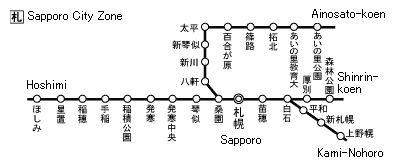 |
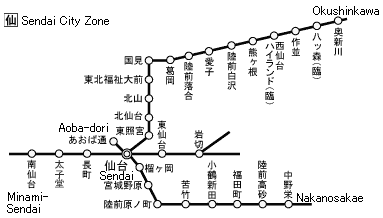 |
 |
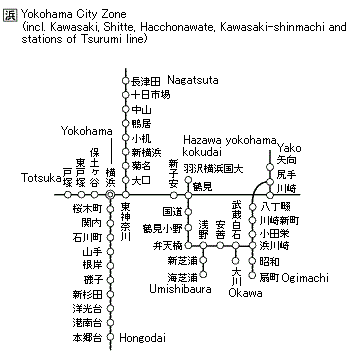 |
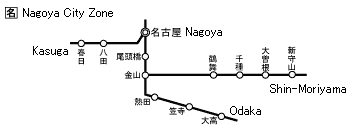 |
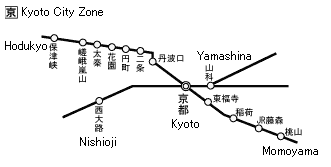 |
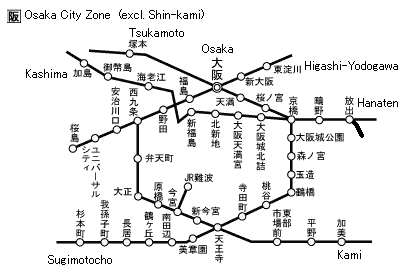 |
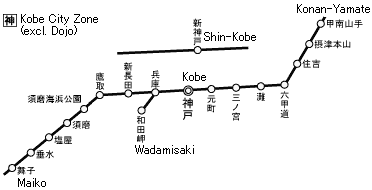 |
 |
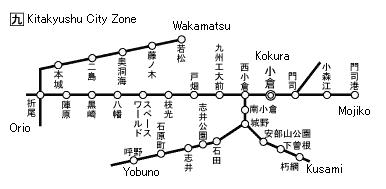 |
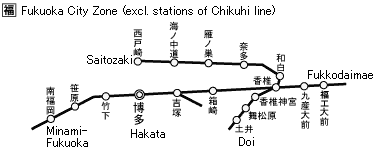 |
Orikaeshi Jōsha 折返し乗車(Duplicated Route): A holder of a ticket issued according to this rule may take a duplicated route for connecting trains (Article 150 of Standard). For example a passenger who has a ticket from Tokyo City Zone to Matsumoto may travel first from Nishi-Ogikubo to Shinjuku and then back to Matsumo by changing the train at Shinjuku.
Kukangai-Jōsha 区間外乗車 (Riding on Non-ticketed section): A holder of a ticket from or to Osaka City Zone may travel through Amagasaki (not in Osaka City Zone) between Tsukamoto and Kashima, without paying an additional fare for the non-ticketed route, if not terminating the journey at Amagasaki (Article 150, Section 2 of Standard).
Sentaku-Jōsha 選択乗車 (Taking an alternative route): A holder of an Ordinary Ticket or a Multiple Ticket whose journey is completed within the respective area shown in the maps below may take an alternative route other than the route indicated on the ticket (Article 157, Section 2).
This is a rule for the validity of the ticket allowing a passenger to take an alternative route within the area, and is not a rule for fare calculation based on the shortest route available in the area as in the case of Tokyo Loop Zone. However, it virtually turns to a rule to charge the lowest fare between the starting and terminating stations within the area, as the use of IC card ticket is growing.
Tokyo Suburban Area

Note: All Shinkansen lines are not included in Tokyo Suburban Area. |
Osaka Suburban Area

Note: Shinkansen between Shin-Osaka and Nishi-Akashi is not included in Osaka Suburban Area. |
Fukuoka Suburban Area
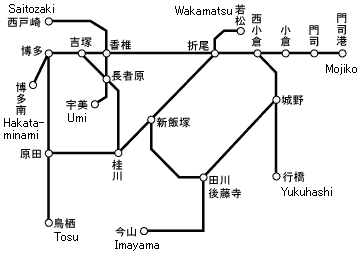
Note: Shinkansen between Kokura and Hakata is not included in Fukuoka Suburban Area. |
|
Niigata Suburban Area
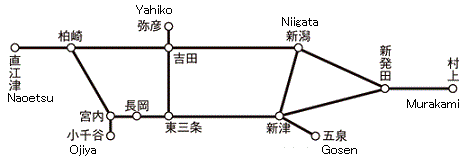
Note: Shinkansen between Nagaoka and Niigata is not included in Niigata Suburban Area. |
Sendai Suburban Area
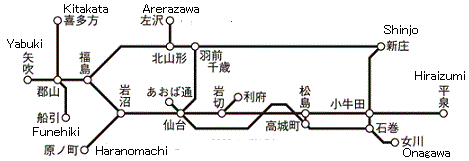
Note: Shinkansen between Koriyama and Ichinoseki is not included in Sendai Suburban Area, as well as using limited express trains between Fukushima and Shinjo. |
For example, a passenger who travels in Section 1 below between a station beyond Sendai (the solid lines) and a station beyond Ichinoseki (the double lines) may use Tōhoku line via Kogota (the solid line) even if his ticket indicates as the route Tōhoku Shinkansen via Furukawa (the dotted line) or vice versa. In case of Section 3, a passenger holding a ticket from a station beyond Ichinoseki and to a station beyond Mizusawa may use Tōhoku Shinkansen to Mizusawa-Esashi and they continue the journey from Mizusawa.
(1) Sendai = Ichinoseki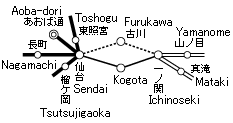 |
(2) Kitakami = Morioka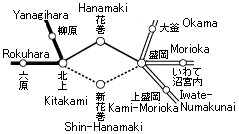 |
(3) Ichinoseki = Mizusawa or Mizusawa-Esashi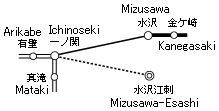 |
(4) Mizusawa or Mizusawa-Esashi = Kitakami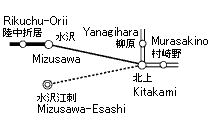 |
(5) Sendai = Ichinoseki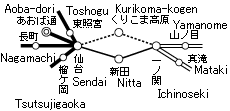 |
(6) Sendai = Kurikoma-kogen or Nitta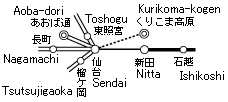 |
(7) Kurikoma-kogen or Nitta = Ichinoseki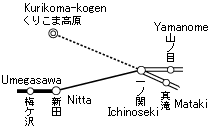 |
(8) Kogota = Kurikoma-kogen or Nitta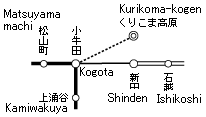 |
(9) Fukushima = Sendai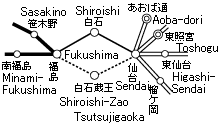 |
(10) Fukushima = Shiroishi or Shiroishi-Zao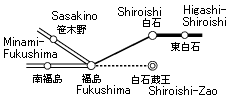 |
(11) Shiroishi or Shiroishi-Zao = Sendai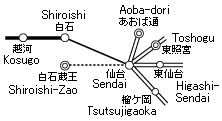 |
(12) Nagaoka = Niigata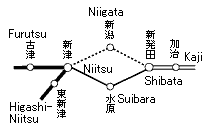 |
(13) Takasaki = Echigo-Yuzawa |
(14) Jomo-kogen or Gokan = Echigo-Yuzawa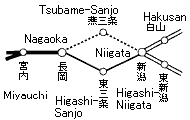 |
(15) Takasaki = Jomo-kogen or Gokan |
(16) Kumagaya = Takasaki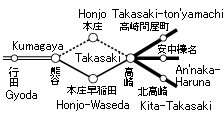 |
(17) Kumagaya = Honjo-Waseda or Honjo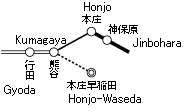 |
(18) Honjo-Waseda or Honjo = Takasaki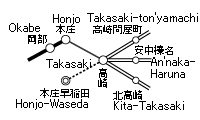 |
(19*) Odawara = Between Shin-Yokohama and Yokohama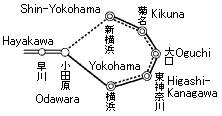 |
(20) Odawara = Shinagawa |
(21) Odawara = Higashi-Kanagawa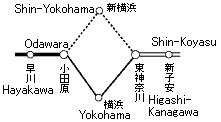 |
(22*) Shiojiri = Tatsuno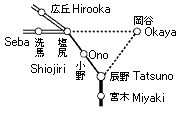 |
(23) Fuji or Shin-Fuji = Mishima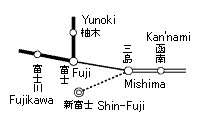 |
(24) Shizuoka = Fuji or Shin-Fuji |
(25) Shizuoka = Mishima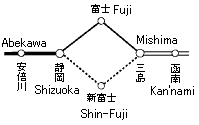 |
(26**) Gifu or Gifu-Hajima = Nagoya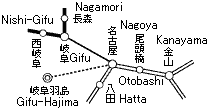 |
(27) Maibara = Gifu or Gifu-Hajima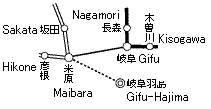 |
(28) Maibara = Nagoya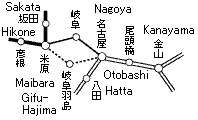 |
(29*) Nishi-Akashi = Osaka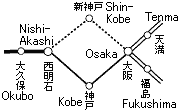 |
(30) Nishi-Akashi = Shin-Osaka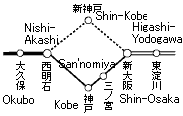 |
(31) Shin-Kobe or Kobe = Shin-Osaka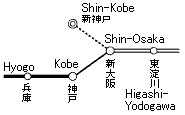 |
(32) Nishi-Akashi = Shin-Kobe or Kobe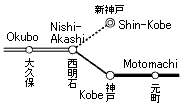 |
(33) Higashi-Okayama = Aioi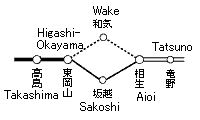 |
(34) Iyo-Ozu = Mukaibara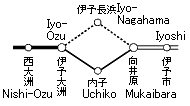 |
(35) Shin-Onomichi or Onomichi = Fukuyama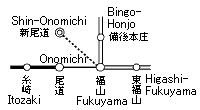 |
(36) Mihara = Shin-Onomichi or Onomichi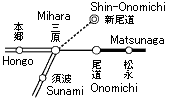 |
(37) Mihara = Fukuyama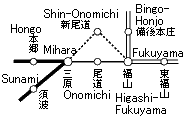 |
(38) Higashi-Hiroshima or Saijo = Mihara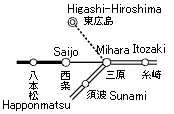 |
(39) Hiroshima = Higashi-Hiroshima or Saijo |
(40) Hiroshima = Mihara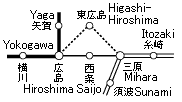 |
(41) Shin-Iwakuni or Iwakuni = Hiroshima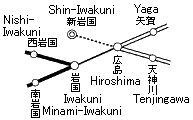 |
(42) Tokuyama = Shin-Iwakuni or Iwakuni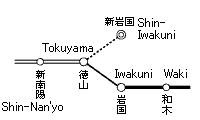 |
(43) Tokuyama = Hiroshima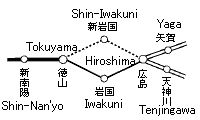 |
(44) Asa = Ino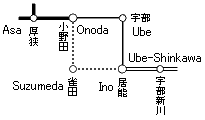 |
(45) Ube = Shin-Yamaguchi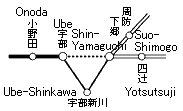 |
(46) Hakata = Shin-Tosu or Tosu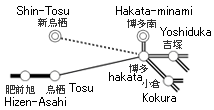 |
(47) Kurume = Shin-Tosu or Tosu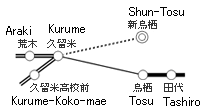 |
(48) Hakata = Kurume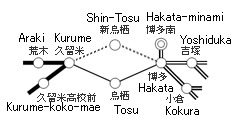 |
(49) Chikugo-Funagoya = Kumamoto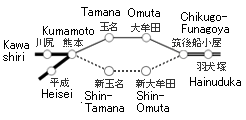 |
(50) Chikugo-Funagoya = Shin-Omuta or Omuta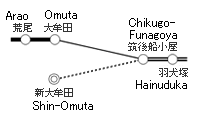 |
(51) Chikugo-Funagoya = Shin-Tamana or Tamana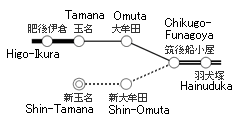 |
(52) Omuta = Tamana or Shin-Omuta = Shin-Tamana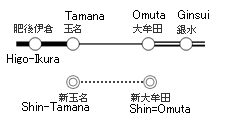 |
(53) Kumamoto = Shin-Omuta or Omuta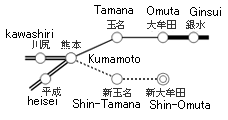 |
(54) Kumamoto = Shin-Tamana or Tamana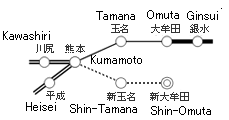 |
(55) Urakami = Kikitsu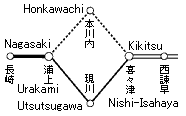 |
(56*) Between Nishi-Urakami and Nagayo = Kikitsu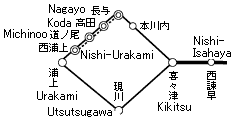 |
(57*) Urakami = Between Honkawachi and Higashisono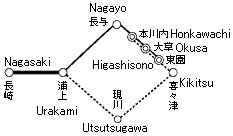 |
* Stopovers are not allowed in case of taking an alternate route not designated in the ticket.
** The Alternae route cannot be chosen for a ticket between Nagoya, Otobashi or Kanayama and Gifu or Gifu-Hajima. |
||
| Route passed by Express Train | Shorter Route applicable to Fare Calculation | Trains |
| Akabane to Ikebukuro by Tōhoku and Yamanote lines | Akabane line | Narita Express. Also applicable to local or rapid trains such as Shonan-Shinjuku line |
| Yoyogi to Kinshicho by Yamanote, Tōkaidō (Shinagawa = Tokyo) and Sobu (Tokyo = Kinshicho) lines | Chuo and Sobu (Ochanomizu = Kinshicho) | Narita Express |
| Amagasaki to Wadayama by Tōkaidō, San'yō and Bantan lines | Fukuchiyama and San'in lines | Hamakaze |
(1) Nippori = Tokyo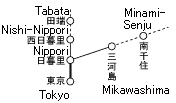 |
(2) Nippori = Ueno |
(3) Shinagawa = Osaki |
(4) Tsurumi = Musashi-Kosugi |
(5) Shin-Kawasaki = Musashi-Kosugi |
(6) Tsurumi = Yokohama / Tsurumi = Musashi-Kosugi |
(7) Tsurumi = Yokohama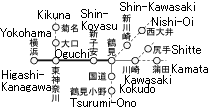 |
(8) Musashi-Shiraishi = Anzen |
(9) Imamiya = Shin-Imamiya |
(10) Utadu = Sakaide |
(11) Orio = Kurosaki |
Bunki-eki Tsuka Ressha 分岐駅通過列車(Train passing the blanching station ): A passenger who travels from or to a line blanched off at the station on the left in the list below and uses an express train that does not stop at such station may ride on a train between the respective two stations, without paying an additional fare for the non-ticketed route, unless he or she makes a stopover on the route (Article 151 of Standard).
| Higashi-Kushiro = Kushiro | Higashi-Kanagawa = Yokohama | Utadu = Marugame |
| Shin-Asahigawa = Asahigawa | Kanda = Tokyo | Tadotsu = Marugame |
| Shiroishi = Sapporo | Yoyogi = Shinjuku | Ikeya = Shozui |
| Soen = Sapporo | Shiojiri = Matsumoto | Sako = Tokushima |
| Numanohata = Tomakomai | Kanayama = Nagoya | Tsukuda = Awa-Ikeda |
| Goryokaku = Hakodate | Tsubata = Kanazawa | Mukaibara = Iyo-shi |
| Nakaoguni = Kanita | Echzen-Hanando = Fukui | Kita-Uwajima = Uwajima |
| Kawabe = Hirosaki | Omi-Shiotsu = Tsuruga | Kaidaichi = Hiroshima * |
| Oiwake = Akita | Yamashina = Kyoto | Yokogawa = Hiroshima |
| Uzen-Chitose = Yamagata | Shin-Osaka = Osaka | Hatabu = Shimonoseki |
| Kita-Yamagata = Yamagata | Osaka = Shin-Osaka | Nishi-Kokura = Kokura |
| Asaka-Nagamori = Koriyama | Amagasaki = Osaka | Yoshiduka = Hakata |
| Amarume = Sakata | Kubota = Saga | Miyauchi = Nagaoka |
| Higashi-Okayama = Okayama | Jono = Kokura | Hoshakuji = Utsunomiya |
| Kurashiki = Okayama | Yoake = Hida | Shin-Maebashi = Takasaki |
| Uto = Kumamoto | Kuragano = Takasaki | Bicchu-Kojiro = Niimi |
| Tayoshi = Minami-Miyazaki | Hoki-Daisen = Yonago | |
| * incl. in case of use of Shinkansen between Hiroshima and a station beyond Mihara | ||
Orikaeshi Ressha 折返し列車(Train duplicating the route): A passenger who rides an express train which duplicates the route shown in the list below may ride on a train between the respective two stations, without paying an additional fare for the non-ticketed route, unless he or she makes a stopover on the route (Article 152 of Standard).
| Sapporo = Shiroishi | Miyauchi = Nagaoka | Hatabu = Shimonoseki |
| Hakodate = Goryokaku | Nishi-Kokura = Kokura |
| Type of Ticket | Conditions to sell |
| Shitei-seki Tokkyū-ken 指定席特急券 (Reserved Seat Ticket) | Sold for use of reserved seat or berth of a Limited Express Train |
| Tachiseki Tokkyū-ken 立席特急券 (Standing Seat Ticket) | Sold without seat reservation for ordinary cars (including a B-type berth used as a seat) of a Limited Express Train of which all seats are reserved |
| Jiyu-seki Tokkyū-ken 自由席特急券 (Non-reserved Seat Limited Express Ticket) | Sold for a non-reserved seat (including a B-type berth used as a seat) of a Limited Express Train |
| Tokutei Tokkyū-ken 特定特急券 (Special Limited Express Ticket) | Sold at a discounted price without seat reservation on a designated train or for a deignated section as shown below |
| Futsu Kyūkō-ken 普通急行券 (Ordinary Express Ticket) | Sold for use of a seat or a berth of an Ordinary Express Train |
Tokutei Tokkyū-ken: Tokutei Tokkyū-ken is sold at a discounted price without seat reservation for the trains and sections shown below.
| Line | Sections |
| Shinkansen | Between two adjacent stations (except Kyūshū Shinkansen between Shin-Yatsushiro and Sendai) and the following sections:
Tokyo = Shin-Yokohama, Mishima = Shizuoka, Shizuoka = Hamamatsu, Toyohashi = Nagoya, Fukuyama = Mihara, Mihara = Hiroshima, Shin-Yamaguchi = Shin-Shimonoseki, Tokyo = Omiya, Furukawa = Ichinoseki, Ichinoseki = Kitakami, Kitakami = Morioka, Kumagaya = Takasaki, Hakata = Kurume |
| Between a Shinkansen station from Tokyo to Shin-Shimonoseki and Shin-Tosu or Kurume | |
| Between Kokura and a Shinkansen station from Chikugo-Funagoya to Kagoshima-Chuo | |
| Kokura = Shin-Tosu and Kokura = Kurume | |
| On-board "Nozomi" or "Mizuho" except between two stations from Hakata to Kagoshima-Chuo | |
| Between a Shinkansen station from Tokyo to Shin-Aomori and Oku-Tsugaru-Imabetesu | |
| Shichinohe-Towada = Kikonai and Shichinohe-Towada = Shin-Hakodate-Hokuto | |
| Shichinohe-Towada = Oku-Tsugaru-Imabetesu | |
| Between two stations from Morioka to Shin-Hakodate-Hokuto | |
| Zairaisen | Between two stations from Tottori to Izumo-shi (except sections <=100km) |
| Between two stations from Yonago to Masuda (except sections <=100km) | |
| Between two stations from Morioka to Akita (via Tazawako and Ou lines) |
Connecting Train Discount Noritsugi Waribiki 乗継割引 (Connection Discount) The Connection Discount is applied for the following connections of Express trains on the same or next day (only the same day for the connection from Shinkansen to Zairaisen).
| Connection | Connecting Station | Discount applied |
| Between Shinkanse and Zairaisen Express trains | All Tōkaidō/San'yō Shinkanse stations between Shin-Yokohama and Shin-Shimonoseki and Osaka, Sakaide/Takamatsu a Tōhoku Shinkanse Shin-Aomori or Aomori b Jōetsu Shinkansen Nagaoka and Niigata Hokuriku Shinkansen Nagano, Naoethsu c, Kanazawa and Tsubata d | 50% discount for Zairaisen Express Ticket |
| Between "Sunrise Seto" and Limited Express trains of JR Shikoku | Sakaide or Takamatsu | 50% discount for JR Shikoku Express Ticket |
Seasonal Charge: Charge for Reserved Seat Limited Express Ticket depends (with some exceptions) on the season of the year; Hanbo-ki (繁忙期) or Peak Season, Tsujo-ki (通常期) or Regular Season and Kansan-ki (閑散期) or Off Season. The Charges are 200 yen more for Peak Season and 200 yen less for Off Season than those of Regular Season.
Shinkansen: Charge for Shinkansen Reserved Seat Ticket is determined for the departing and arriving stations for each of the lines and the type of trains, while it is roughly based on the Eigyō-kilo travelled. Express Fare of Tōkaidō/San'yō Shinkansen and Kyūshū Shinkansen is separately calculated for the respective section even if "MIzuho" or "Sakura" runs through the both San'yō and Kyūshū Shinkansen. While there is "Hayabusa" direct service, Express Fare of Tōhoku Shinkansen and Hokkaidō Shinkansen is also separately calculated for the respective section.
Zairaisen: Express Charge is determined according to the Eigyō-kilo travelled for the category A and Category B, with many exceptions such as Tokutei Tokkyū Ryōkin. Category B is different for each JR Company. Category B sections are shown in the chart below.

Note: